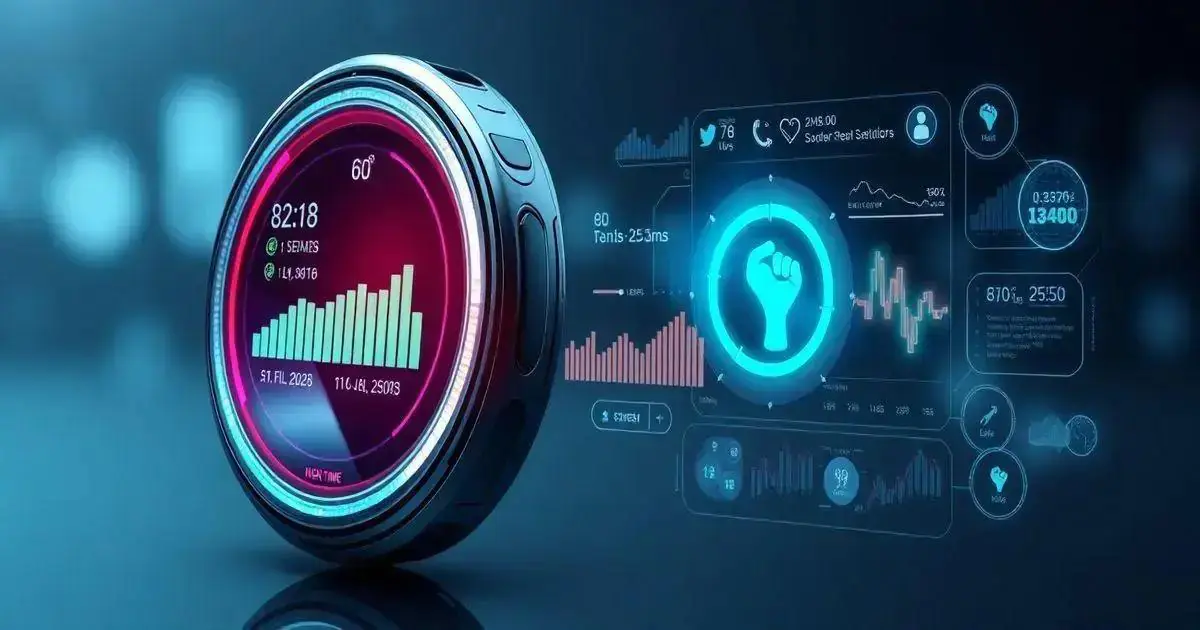Wearable health devices track testosterone levels for men by using advanced sensors to monitor hormonal changes in real-time, offering insights that enhance overall health, performance, and emotional well-being.
In recent years, women’s health has gained significant attention, but the role of testosterone in men’s health is equally critical. Wearable health devices are now paving the way for men to monitor their testosterone levels effortlessly. These innovative tools not only track hormone levels but also promote a more significant understanding of overall health. As we investigate how wearable devices are tracking testosterone levels for men, we will uncover the benefits and future trends of this technology.
Understanding Testosterone and Its Importance

Testosterone is a vital hormone in men’s health. It plays a crucial role in various bodily functions, including muscle growth, bone density, and mood regulation. Many associate testosterone with physical strength, but its effects go much deeper.
The Role of Testosterone
Testosterone affects not only physical attributes but also mental well-being. A balanced testosterone level contributes to higher energy levels, improved mood, and cognitive function. Conversely, low levels can lead to fatigue, depression, and decreased motivation.
Why Monitoring Testosterone Matters
Understanding testosterone levels can help men make informed decisions about their health. Regular monitoring allows individuals to recognize any significant changes early, which can lead to timely interventions. This is where wearable health devices come into play, offering accessible and real-time data on hormone levels.
Testosterone Across the Lifespan
Testosterone levels naturally fluctuate with age. Typically, levels peak in early adulthood and gradually decline over time. It’s essential for men to be aware of these changes and their potential impact on health.
In summary, recognizing the importance of testosterone is crucial for overall health. By understanding its role and regularly monitoring levels, men can take proactive steps to maintain their well-being.
The Role of Wearable Devices in Hormone Tracking
![]()
Wearable health devices have transformed how we monitor our bodies, especially hormone levels like testosterone. These devices include smartwatches, fitness trackers, and specialized health monitors designed to provide real-time data about our health.
How They Work
Most wearable devices track hormone levels through sensors that analyze biomarkers found in sweat, blood, or other body fluids. For testosterone, they may use optical sensors to detect changes indicative of hormonal shifts.
Access to Data
One significant advantage of these devices is that they offer easy access to health data. Users can see their testosterone levels at a glance on their phones or smart displays, enabling them to make informed decisions about lifestyle and health.
Integration with Other Health Metrics
Wearable devices do not only track testosterone; they also monitor other vital signs like heart rate, sleep patterns, and activity levels. This integration provides a broader view of health, enabling users to understand how various factors may influence hormone levels.
User Engagement
These devices often include features like reminders, alerts, and health goals, which engage users in their health management. The constant feedback encourages a proactive approach to maintaining healthy testosterone levels.
Benefits of Monitoring Testosterone Levels

Monitoring testosterone levels offers many benefits for men’s health. First and foremost, it provides insight into overall health. Low testosterone can lead to various health issues, including fatigue, mood changes, and decreased libido. By tracking these levels, men can take action before issues become serious.
Improved Health Awareness
Regularly monitoring testosterone helps men become more aware of their health. This awareness encourages them to adopt healthier lifestyles, such as exercising, maintaining a balanced diet, and managing stress. These changes can positively impact testosterone levels.
Personalized Health Management
With data from wearable devices, men can track their testosterone levels alongside other health metrics. This allows for personalized health management that suits individual needs. Men can work with healthcare providers to create tailored plans based on the data.
Enhanced Performance
For active individuals, monitoring testosterone can lead to enhanced physical performance. Adequate testosterone levels support muscle growth and stamina, which is vital for athletes. Wearable devices enable users to adjust their training regimens based on their hormonal status.
Emotional and Mental Health Benefits
Understanding testosterone levels can have significant emotional and mental health benefits. It helps men recognize links between their hormone levels and mood changes. By addressing hormonal imbalances, men can improve their mental well-being and emotional stability.
Future Trends in Wearable Health Technology

The future of wearable health technology looks promising and innovative. As technology advances, we can expect wearable devices to become even more sophisticated in tracking hormone levels, including testosterone. This advancement will come from improved sensor technology that provides more accurate data.
Integration with Advanced AI
Wearable devices will likely use advanced AI capabilities to analyze data trends over time, offering personalized insights. This means they can recommend lifestyle adjustments or healthcare consultations based on a user’s historical hormone data.
Enhanced Connectivity
We can also expect better connectivity with other health-monitoring devices. As a result, data from different gadgets will be synchronized, allowing for a comprehensive health overview. This will enable users to see how their testosterone levels relate to other health indicators.
Wearable Health Platforms
The future may bring integrated health platforms that combine data from wearables with telehealth services. This will make it easier for users to communicate with healthcare providers, getting instant feedback on their testosterone levels and overall health.
Real-time Monitoring and Alerts
Future wearables may offer real-time monitoring and alerts for testosterone fluctuations. This could help men respond promptly to any changes that may require medical attention, making health management more proactive.
In Conclusion: Empowering Men’s Health with Wearable Technology
Wearable health devices are revolutionizing the way men monitor their testosterone levels, offering valuable insights into overall health and wellness.
As we explored, understanding testosterone’s role is vital, and the integration of technology enables real-time tracking, encouraging proactive health management.
The benefits of monitoring testosterone are manifold, from improved physical performance to enhanced emotional well-being. With future trends pointing towards even more advanced features, these devices will continue to play a crucial role in men’s health.
By embracing these technologies, men can take charge of their health, unlock new levels of vitality, and lead healthier, more fulfilling lives.
FAQ – Frequently Asked Questions About Wearable Health Devices and Testosterone
How do wearable health devices track testosterone levels?
Wearable devices use sensors to analyze biomarkers in sweat or blood, providing real-time data on testosterone levels.
What are the benefits of monitoring testosterone levels?
Monitoring testosterone levels helps improve health awareness, offers personalized health management, enhances performance, and supports emotional well-being.
Can wearable devices improve my overall health?
Yes, by providing insights into your hormone levels, wearable devices can help you make informed lifestyle choices that promote better health.
What future trends can we expect in wearable health technology?
Future trends include enhanced AI integration, improved connectivity with other health devices, and real-time monitoring with alerts for hormonal changes.
Is tracking testosterone levels with a wearable device accurate?
Most modern wearable devices are designed to provide accurate readings, although it’s essential to consult with healthcare providers for validation and detailed analysis.
How can I use the data from wearable devices effectively?
Use the collected data to identify patterns, make lifestyle modifications, and work with healthcare professionals to optimize your health management.











